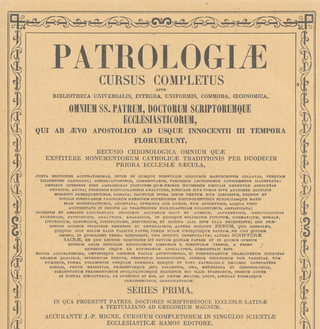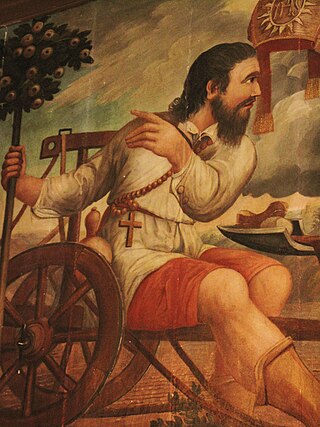Early life
Born into a noble family, he was sent as a child for his education, first to Sigulfe, abbot of Ferrières, and then to Marcward, abbot of Prüm near Trier. After the death of Marcward in 853, Ado went to Rome where he stayed for nearly five years, and then to Ravenna, after which Remy, archbishop of Lyon, gave him the parish of Saint-Romain near Vienne. The following year he was elected archbishop of Vienne and dedicated in August or September 860, despite opposition from Girart de Roussillon, Count of Paris, and his wife Berthe. [7]
Writings
Ado's chronicle is based on that of Bede, with which he combines extracts from the ordinary sources, forming the whole into a consecutive narrative founded on the conception of the unity of the Roman Empire, which he traces in the succession of the emperors, Charlemagne and his heirs following immediately after Constantine VI and Irene. "It is," says Wilhelm Wattenbach, "history from the point of view of authority and preconceived opinion, which exclude any independent judgment of events." [6]
Ado wrote also a book on the miracles ( Miracula ) of Saint Bernard, archbishop of Vienne (9th century), published in the Bollandist Acta Sanctorum ; a life or martyrium of Saint Desiderius, bishop of Vienne (d. 608); [8] and a life of Saint Theuderius of Vienne, otherwise known as Theudericus of the Dauphinê, abbot of Saint-Chef near Vienne (563). [6] [9]
Aimoin of Fleury, French chronicler, was born at Villefranche-de-Longchat, Southwestern France about 960. Early in his life he entered the monastery of Fleury, where he became a monk and then passed the greater part of his life. Between c. 980 and 985 Aimoin wrote about St. Benedict in Abbey of Fleury-sur-Loire. His chief work is a Historia Francorum, or Libri V. de Gestis Francorum, which deals with the history of the Franks from the earliest times to 653, and was continued by other writers until the middle of the twelfth century. It was much in vogue during the Middle Ages, but its historical value is now regarded as slight. It was edited by G. Waitz and published in the Monumenta Germaniae Historica: Scriptores, Band xxvi.

The Bollandist Society are an association of scholars, philologists, and historians who since the early seventeenth century have studied hagiography and the cult of the saints in Christianity. Their most important publication has been the Acta Sanctorum. They are named after the Flemish Jesuit Jean Bollandus (1596–1665).

Regino of Prüm or of Prum was a Benedictine monk, who served as abbot of Prüm (892–99) and later of Saint Martin's at Trier, and chronicler, whose Chronicon is an important source for late Carolingian history.

Hilary of Arles, also known by his Latin name Hilarius, was a bishop of Arles in Southern France. He is recognized as a saint by the Roman Catholic and Eastern Orthodox Churches, with his feast day celebrated on 5 May.

Benedict of Aniane, born Witiza and called the Second Benedict, was a Benedictine monk and monastic reformer, who left a large imprint on the religious practice of the Carolingian Empire. His feast day is either February 11 or 12, depending on liturgical calendar.

The Patrologia Latina is an enormous collection of the writings of the Church Fathers and other ecclesiastical writers published by Jacques-Paul Migne between 1841 and 1855, with indices published between 1862 and 1865. It is also known as the Latin series as it formed one half of Migne's Patrologiae Cursus Completus, the other part being the Patrologia Graeca of patristic and medieval Greek works with their medieval Latin translations.
A martyrology is a catalogue or list of martyrs and other saints and beati arranged in the calendar order of their anniversaries or feasts. Local martyrologies record exclusively the custom of a particular Church. Local lists were enriched by names borrowed from neighbouring churches. Consolidation occurred, by the combination of several local martyrologies, with or without borrowings from literary sources.

The Martyrologium Hieronymianum or Martyrologium sancti Hieronymi is an ancient martyrology or list of Christian martyrs in calendar order, one of the most used and influential of the Middle Ages. It is the oldest surviving general or "universal" martyrology, and the precursor of all later Western martyrologies.

The Four Crowned Martyrs or Four Holy Crowned Ones were nine individuals who are venerated as martyrs and saints of Early Christianity. The nine saints are divided into two groups:
- Severus, Severian(us), Carpophorus (Carpoforus), Victorinus
- Claudius, Castorius, Symphorian (Simpronian), Nicostratus, and Simplicius

The Martyrology of Usuard is a work by Usuard, a monk of the Benedictine Abbey of Saint-Germain-des-Prés. The prologue is dedicated to Charles the Bald indicating that it was undertaken at that monarch's instigation. It was apparently written shortly before the author's death in 875.
Herigerus was a Benedictine monk, often known as Heriger of Lobbes for serving as abbot of the abbey of Lobbes between 990 and 1007. Remembered for his writings as theologian and historian, Herigerus was a teacher to numerous scholars. His biography describes him as "skilled in the art of music", though no music theory treatise survives and neither do the two antiphons and one hymn attributed to him.

Saint Benignus of Dijon was a martyr honored as the patron saint and first herald of Christianity of Dijon, Burgundy. His feast falls, with All Saints, on November 1; his name stands under this date in the Martyrology of St. Jerome.
The Archbishopric of Vienne, named after its episcopal seat in Vienne in the Isère département of southern France, was a metropolitan Roman Catholic archdiocese. It is now part of the Archdiocese of Lyon.
Milo Crispin was cantor of the Benedictine Abbey of Bec. He wrote the lives of five of its abbots: Lanfranc, Archbishop of Canterbury, Gulielmus de Bellomonte, Boso, Theobaldus, and Letardus.
Osbern of Canterbury or Monk Osbern was a Benedictine monk, hagiographer and musician, precentor of Christ Church, Canterbury.

Prudentius was bishop of Troyes, a chronicler and an opponent of Hincmar of Reims in the controversy on predestination.
Heribert Rosweyde was a Jesuit hagiographer. His work, quite unfinished, was taken up by Jean Bolland who systematized it, while broadening its perspective. This is the beginning of the association of the Bollandists.
Virgilius of Arles was Archbishop of Arles in Gaul.
Folcard or Foulcard was a Flemish hagiographer.

Saint John I Agnus was the 25th bishop of Tongres. He lived in the 7th century and is considered as a saint by the Roman Catholic Church.










